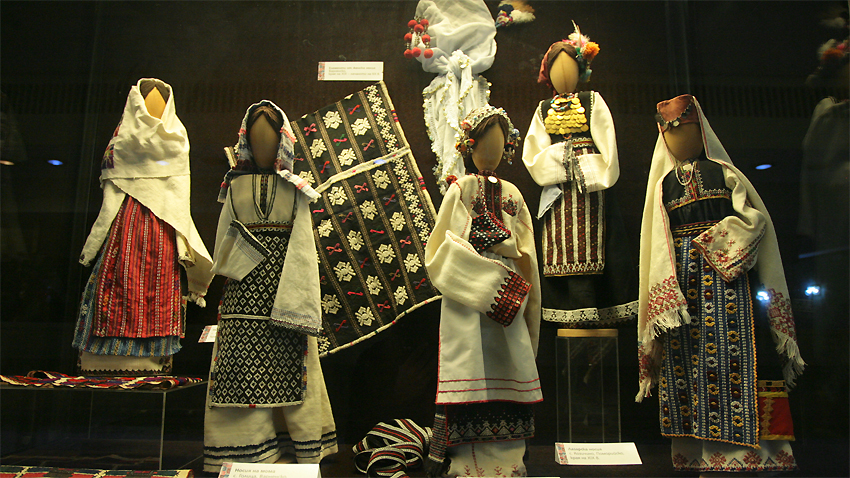 3
3
An exhibition is on at the National Museum of History with the motto “Creativity recreated”. It displays splendid embroidery pieces from the Bulgarians lands, as well as traditional costumes and jewelry. A wealth of traditional folk costume designs from various regions is shown in downsized versions on dolls. More about the display from curator Antoaneta Ivanova:

„Embroidery pieces are typical of aprons, tunics and shirts. The costumes in downsized versions were designed in the 1980s by Antonia Vevela. She was a restorer in the museum, and based her work on the travel notes of famous traveler, ethnographer and geographer Felix Kanitz, as well as on the works of great artist Ivan Mrkvicka. Also, the works of leading ethnographer Maria Veleva have provided precious reference. The exhibition shows two-apron garments, tunics and saya frocks characteristic of western Bulgaria. On display are folk costumes from the regions of Pleven, Sofia, Stara Zagora, Northeastern Bulgaria, the Rhodope Mountains, Bansko and other regions. In each showcase we feature replicas of dolls with traditional costumes and embroidery pieces are the originals.”
 For the first time the visitors can also see a reenactment of the so-called sokayhead covering. The sokay is a kind of a diadem used by married women in the central Bulgarian regions of Gabrovo, Tryavna, Veliko Tarnovo, Sevlievo and Kilifarevo. It consists of a wooden pad, a white headscarf decorated with embroidery. Also, there is another jewel - the krazhilo that has metal decorations such as small coins. Some researchers find the roots of the sokay head covering in the royal and boyar costumes in the Second Bulgarian Kingdom (1185 - 1396). The sokay is given to the young bride by her mother-in-law as a token of continuity. The more affluent the bridegroom's family, the bigger the adornments applied while covering the head.
For the first time the visitors can also see a reenactment of the so-called sokayhead covering. The sokay is a kind of a diadem used by married women in the central Bulgarian regions of Gabrovo, Tryavna, Veliko Tarnovo, Sevlievo and Kilifarevo. It consists of a wooden pad, a white headscarf decorated with embroidery. Also, there is another jewel - the krazhilo that has metal decorations such as small coins. Some researchers find the roots of the sokay head covering in the royal and boyar costumes in the Second Bulgarian Kingdom (1185 - 1396). The sokay is given to the young bride by her mother-in-law as a token of continuity. The more affluent the bridegroom's family, the bigger the adornments applied while covering the head.
„Head covering for young girls used to be beautiful but not as colorful as the one for married women. The exhibition also shows embroidery that was specifically applied to aprons, as well as embroidery for shirts, the neckline, sleeves and tunics.”

Of course, on festive days for the community, the Bulgarians of pre-modern time wore clothes with a great diversity of embroideries and ornaments. The special festive costumes were more colorful and girls felt proud to dress up and demonstrate how they have decorated their clothing.
English Daniela Konstantinova
Photos: BGNES and Veneta PavlovaVFU (Visionary Font Ultra) – this is the name a third-year student from Varna Free University, Volodymyr Fedotov, has given to the font he is presenting at the International Triennial of Typography in Poland. “To create a font takes a sense of..
On the 143 rd birth anniversary of foremost Bulgarian painter Vladimir Dimitrov-the Master, an award ceremony will take place at the art gallery in the town of Kyustendil, at which the national prize for painting for 2024 will be awarded...
The new Bulgarian film "Don't Close Your Eyes", which premieres in cinemas across the country on January 31, explores the miracles of life and the ability to follow our path without losing faith. In a nutshell, the story revolves around a priest,..

+359 2 9336 661
